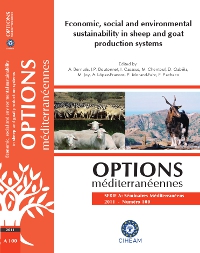| Article précédent | p. 145-149 | Article suivant |
Evolution of technical-economic indicators for Andalusian grazing dairy goats (2006-2008)
The aim of this work is to analyse the evolution of 10 technical-economic indicators during the period 2006-2008 in 6 pastoral farms of Andalusia (Spain) in order to observe the most determinant factors for the viability of systems. For the technical-economic analysis, an adaptation of the FAO/CIHEAM indicators list has been used. Values of indicators for each year and also for the whole of the period have been obtained. By consequence of increases of quantity and price of feed, economic margins of farms decreased from 2006 to 2008. Although the milk prices also increased, the proportion of the increase was less than in the feed price. While in 2008 the family net margin and, overall, the business net margin per litre of milk sold, were very low, the family net margin per unit of family labour was fairly acceptable. The meaning of this situation is that, at present, farms can survive because a part of the pay of family workers is used to purchase feed. Several regression analyses have been made. Only in two cases is there a significant level: the business net margin per litre of milk sold in comparison to the milk sold per goat and the family net margin per unit of family labour in comparison to the total labour.
L'objectif de cet article est d'analyser l'évolution de 10 indicateurs technico-économiques pendant la période 2006-2008 dans 6 exploitations pastorales d'Andalousie (Espagne) afin d'observer les facteurs qui déterminent la viabilité des systèmes. Pour réaliser l'analyse technico-économique, des indicateurs adaptés de la liste de FAO/CIHEAM ont été utilisés et les valeurs des indicateurs pour chaque année et aussi pour l'ensemble de la période ont été obtenus. Les marges économiques des exploitations ont baissé entre 2006 et 2008 à cause de l'augmentation des quantités et du prix des aliments consommés par les chèvres. Bien que le prix du lait ait aussi augmenté, la proportion de cette augmentation a été inférieure à celle du prix des aliments. Tandis qu'en 2008, la marge nette familiale et, surtout, la marge nette de l'entreprise par litre de lait vendu ont été très basses, la marge nette familiale par UTH a été plus ou moins acceptable. Cette situation implique qu'actuellement, les exploitations peuvent survivre parce qu'une partie du salaire qui devrait être assigné aux travailleurs familiaux, est destinée à l'achat d'aliments pour les chèvres. Plusieurs analyses de régression ont été réalisées. Un niveau de signification n'a été trouvé que dans deux cas : la marge nette de l'entreprise par litre de lait vendu selon le lait vendu par chèvre et la marge nette familiale par UTH selon la main-d'oeuvre totale.
- [ Afficher ]
- [ Télécharger ]
- [ Exporter la citation ]
Vous pouvez télécharger la citation au format :
- [ Imprimer ]
-
Mots-clés
CAPRIN, ESPAGNE, EXPLOITATION LAITIERE, INDICATEUR ECONOMIQUE, SYSTEME DE PATURAGE, VIABILITE ECONOMIQUECiter cet article
Castel J.M., Mena Y., Ruíz F.A., Moya J., Camúñez J. Evolution of technical-economic indicators for Andalusian grazing dairy goats (2006-2008). In : Bernués A. (ed.), Boutonnet J.P. (ed.), Casasús I. (ed.), Chentouf M. (ed.), Gabiña D. (ed.), Joy M. (ed.), López-Francos A. (ed.), Morand-Fehr P. (ed.), Pacheco F. (ed.). Economic, social and environmental sustainability in sheep and goat production systems. Zaragoza : CIHEAM / FAO / CITA-DGA, 2011. p. 145-149. (Options Méditerranéennes : Série A. Séminaires Méditerranéens; n. 100). 7. Proceedings of the International Seminar of the Sub-Network on Production Systems of the FAO-CIHEAM Inter-Regional Cooperative Research and Development Network on Sheep and Goats, 2010/11/10-12, Zaragoza (Spain). http://om.ciheam.org/om/pdf/a100/00801496.pdf



